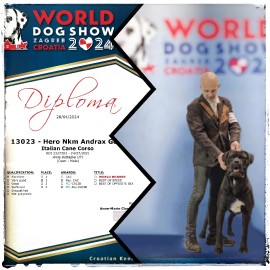Genetic code of colurs Cane corso
Because a lot of people are intersting about genetic colors of Cane corso, you are welcome read this article from Yana Rusakova, Nicola Mille, Elena Ilina...
Rusakova, Elena Ilina, Nicola Mille
The group of authors expresses special appreciation for scientific consultations and help to the RKF consultant in genetics, Ph.D. in biology, expert-cynologist – Ms. Maria Nikolaevna Sotskaia
Translated by Anastasiya Pokrovskaya and last chek in by Federica Depau.
Breed Colors of Cane Corso.
Since ancient times the dog has been man’s companion and assistant. Thanks to careful breeder selection over the years for certain traits, today we have a wide number of various breeds of dogs – from the faithful & brave watchdog to the adored in-house pet. In the process of breeding for certain traits man did not overlook breed colors. With the development of each breed a certain palette of colors was fixed for each one.
Selection by color can lead a breeder in different directions. In one case a certain color is simply his preference, in another – the colors connected with health problems are excluded from the breed, and in the third case- selectors get rid of the colors assuming a metization. As science evolved the biological basis for the appearance of this or that color in the specific phenotype as well as regularities of color inheritance; were all quite well studied.
Hair structure.
The attached image: Cross-section showing the structure of a guard hair – il disegno 001
Before addressing the suject of color, it is necessary to understand, how the hair is structured and what is responsible for its coloring.
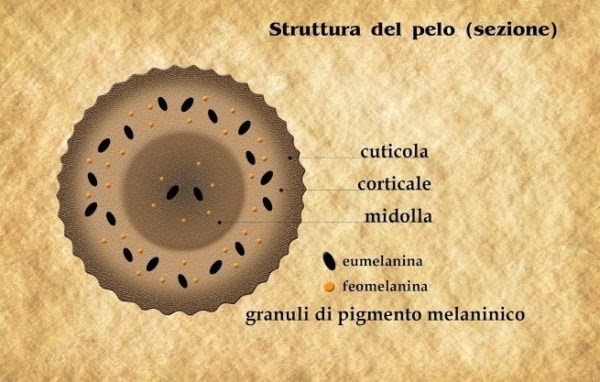
The correct coat of the Cane Corso must have two types of hair – guard hair and undercoat. Each purebred Cane Corso should have undercoat. The Cane Corso is a rural guard dog who; around the clock and under all weather conditions, must be able to perform his job – to protect grazing cattle. The dog who that doesn’t have an undercoat, will not be able to keep himself warm in cold conditions and therefore won’t be able to carry out his job as he should.
Cane Corso without undercoat must be recognized as dogs with a functional defect and are to be excluded from breeding. Lack of the undercoat in a Cane Corso puts into doubt about his lines and we can assume that among his relatives there are dogs of other breeds. For example, boxers, that have no undercoat at all.
But let’s come back to the hair structure. The guard hair consists of a core and a cortical substance in which there are pigment granules, and it is covered with a thin cover – a cuticle. In the undercoat there is no core, and in its cortical layer there is not enough pigment which makes it look much paler. All dog colors are defined by the existence of the pigment – melanin. It is a product of the transformation of amino acid tyrosine. Melanin is formed in specialized cells – melanocytes. The process of melanin formation is called melanogenesis. Melanin is a polymer which, dependending on its chemical condition, is packed into granules of two types:
- Eumelanin – either oblong granules of black or roundish granules of brown, thus only one types of an eumelanin pigment can be present in the organism at once – either black, or brown.
- Feomelanin – roundish granules of yellow color.
The color of a hair depends on the existence, quantity and the arrangement of pigmentary granules in it. This is in turn affacted by alleles a series of several genes which are responsible for the appearance in a phenotype of any particular color.
DNA-chromosomes-genes-alleles-loci
The attached image: Homologous chromosomes, locus, alleles il disegno 002
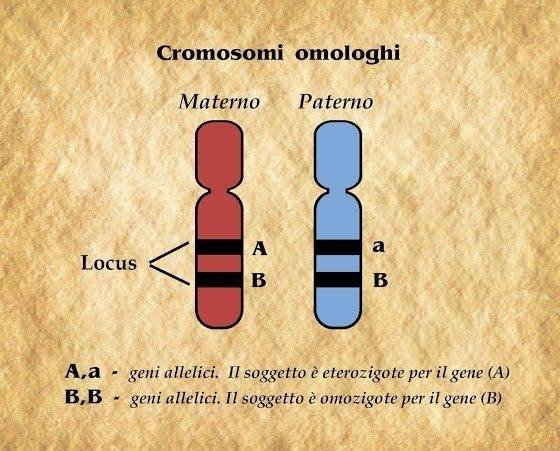
As we know, a structural and functional unit of heredity is a gene which represents a certain region of the DNA molecule and defines the possibility of the appearance of a specific elementary character or of one proteinaceous molecule. Each gene in the organism has its place – a certain chromosome region. This place is called as a locus.
Genes which are located in one locus of the homologous chromosomes and which define alternative options of the same character, are called allelic. In any population there can exist more than two alleles of one gene. This phenomenon carries the name a multiple allelism. But therefore in a specific organism at the same time there can be presented only two alleles of one gene in a number equal to the number of the homologous chromosomes received from the father and the mother. Genes alleles can enter difficult interactions with each other. If in an organism there are two identical alleles of one gene, such an organism is called homozygotic. If there are two different, such an organism is called heterozygotic. Allelic genes are usually referenced to by identical letters – AA, Aa, aa. Thus, if one gene completely suppresses the action of the other gene, it is called dominant, and the suppressed gene is called – recessive.
If in the genotype of an individual there are both variants of a gene – dominant and recessive (a heterozygotic individual), than only a dominant gene phenotypically will be manifesting itself, but the recessive gene could be transferred to any offspring. All dog colors and their shades are defined by 12 loci, in each of which there can be 2 and more variants of gene. Loci can interact among each other. A certain quantity of gene variations is allowed for each breed, but some variations are nonrelevant to any breed. Appearance of these nonrelevant colors in any breed indicates another breed has been added to the gene pool.
Therefore, the appearance of any color and its shade in a phenotype depends on a combination of gene variants received by the dog from its parents, and also somewhat on the internal factors of an organism and the external factors of the environment influencing expressivity, i.e. extent of the appearance of a particular trait.
Alleles causing formation of colors in Cane Corso breed.
1) Locus (A) is presented by alleles of agouti gene.
This term occurred from the name of the South American rodent having a wild brown-gray color, that helps to camouflage it from its predators. Alleles of agouti gene determine zonary distribution of eumelanin and feomelanin pigments, i.e. uneven coloring of the guard hair, and the various maintenance of feomelanin in hair cover of different body parts that results in discoloration into more dark hackle hair and lighter hair cover of abdomen.
Ay – fawn color of different intensity that depends on rufus-polygenes action.
at – defines a tan color in homozygotic condition.
A>at (Ay – dominant, at – recessive) (Ay suppresses at).
2) Locus (B) is presented by following alleles (brown):
B – defines synthesis of black eumelanin;
b – defines synthesis of brown eumelanin in homozygotic condition, thus color of lips, nasal planum, pillows of paws become brown colored.
B>b (B – dominant, b – recessive), (B suppresses b)
3) Locus (D) is presented by alleles D and d, it’s a so-called attenuator (comes from dilution):
D – defines normal intensity of a color;
d – weakens a black color to gray in homozygotic condition, with discoloring of lips, nasal planum, claws pigmentation from black to gray.
D>d (D – dominant, d – recessive), (D suppresses d)
4) Locus (E) is presented by a series of alleles of the extension gene:
Em – defines existence of a “mask” on the dog’s face;
E – normal (full) pigmentation;
e – completely blocks the development of eumelanin in homozygotic condition. Leads to total absence of black hair. In Cane Corso breed there is possibility of manifestation of a non-standard recessive e-fawn color (fawn without a “mask”);
Em>E>e. (Em suppresses E which, in turn, suppresses e).
5) Locus (K) is presented by alleles of a Key gene:
K – defines the dominant black color of a dog;
kbr – defines development of the brindle color;
k – defines possibility of the usual color determined by other loci development. In a homozygotic condition Cane Corso has possibility of a fawn color with a black or gray mask manifestation;
(All fawn dogs with a black or gray mask are kk homozygotes, because allele k is the most recessive in series and therefore it is shown in the phenotype only in a homozygotic condition).
K>kbr>k. (K suppresses kbr which, in turn, suppresses k).
The scale of admissible colors for each breed is always specified in the breed standard. All colors that aren’t included in the standard are undesirable even if they are often seen in some representatives of the Cane Corso. All dogs having a non-standard color, have to be excluded from breeding, in order to prevent further appearances of these undesirable colors in the breed.
The FCI standard No. 343 of the “Cane Corso Italiano” breed states:
“Color: black, lead-grey, slate-grey, light grey, light fawn: stag red and dark fawn; brindle (stripes on different shades of fawn or grey); in fawn colored and brindle dogs the clack or grey mask on the muzzle should not go beyond the line of the eyes. A small white patch on the chest, on the tips of the feet and on the bridge of the nose is acceptable.”
The attached image: Examples of colors il disegno 003
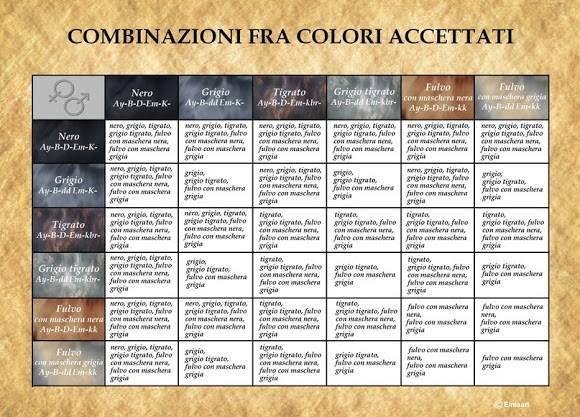
The standard always refers to the phenotipical appearance of a color. If we consider genotypes, we can conditionally divide standard colors into groups of colors, depending on their genotype.
The attached image: Card of standard colors of Cane Corso il disegno 004
Standard colors.
1. Black.
Completely black dogs (small white marks on a throat, breast, fingers are allowed). If there is even just one hair of fawn color on the dog corp, such dog isn’t genetically black. The black color is defined by the combination of alleles: Ay-B-D-Em-K-.
The sign (-) designates that with this locus the dog can be both: homozygotic and heterozygotic & it won’t affect phenotipical manifestation of a color. Black dogs always have well pigmented black inking of lips, eyes and a black pigmented nose.
The black coloured dog can carry a gene pattern that with certain combinations of genes of a potential partner, can give in posterity – dogs of all other colors including non-standard as a recessive.
Let’s sort an example of the birth of a gray puppy from two black dogs:
We breed: Ay-B-DdEm-K-X Ay-B-DdEm-K-
we receive =
Ay-B-DDEm-K-(black puppy);
Ay-B-DdEm-K-(black puppy);
Ay-B-ddEm-K-(a gray puppy with a gray inking of lips, eyelids and a gray nose).
If two black dogs produce a gray puppy, we can claim with confidence that both parents are heterozygotic by locus (D).
2 . Gray.
Standard colors: lead-gray, slate-gray, light-gray are genetically a one color – gray – with different degrees of intensity. The gray color in fact is diluted black and is defined by existence of the recessive homozygote dd in combination with alleles B- & K-.
We can write down a genetic formula of this color as follows: Ay-B-ddEm-K-.
Presence of factor pair dd at the genotype weakens not only color of dog hair from black to gray, but also the pigmentation of lips, eyelids & nose – they too become gray colored.
When crossing two gray dogs the resulting puppies will also receive recessive homozygote dd, and consequently, from two gray dogs the resulting puppies will be of weakened colors – gray, gray brindle, fawn with a gray mask (formentino), including undesirable ones – isabella, gray-and-tan – usual tan or tan brindle .
The appearance of certain colors in offspring will depend on what gene pattern of other loci (except a locus (D) the puppies will receive from their parents.
We breed: Ay-B-ddEm-Kk (gray) X Ay-B-ddEm-KK (gray)
we receive =
Ay-B-ddEm-KK (gray);
Ay-B-ddEm-Kk (gray)
We breed: Ay-B-ddEm-Kkbr (gray) X Ay-B-ddEm-Kkbr (gray)
we receive: =
Ay-B-ddEm-KK (gray),
Ay-B-ddEm-Kkbr (gray),
Ay-B-ddEm-kbrkbr (gray brindle).
The attached image: Black and gray colors il disegno 005
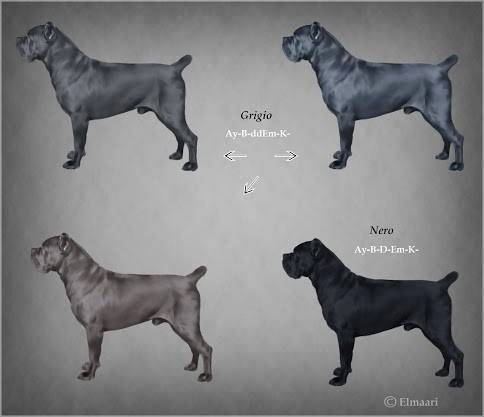
3 . Fawn with a mask.
The attached image: Fawn color with black and gray mask il disegno 006
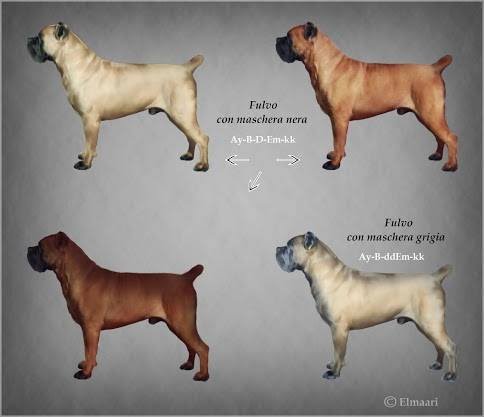
The fawn color in Cane Corso breed shows many variants – light fawn, stag red, dark fawn and all intermediate shades. The intensity of a shade is affected greatly by special polymeric genes named “rufus-polygenes” by Robinson.
Standard fawn colors are caused by a combination of alleles Ay-and kk. Homozygote kk helps fawn color appear in a phenotype, and Ay-presence, in turn, forms hair coloring – fawn with the dark end. The area of hair coloring in a dark color varies from quite deep (dark fawn) to almost invisible to a human eye (light fawn) depending on gene modifiers or the existence of the shading polygenes.
Thus, it becomes obvious that the difference between standard fawn colors and darkened colors in different body parts and/or the head (meaning deeper area of coloring of the hair ends in a dark color) depends on the existence of genes-modifiers, and from the point of the genotype it is the same.
All the results of the action of these gene modifiers have now been studied. Breeding using nimals with excessive hair shading should be avoided in order to remove this fault from future breeding. But it is necessary to consider that from two standard fawn dogs, fawn puppies with excessive hair shading on the head and/or on the body, (and vice versa) can be born. Besides, it becomes obvious that the use of fawn dogs without a mask (a recessive e-fawn color) in breeding is to be frowned upon; because such dogs, unlike fawn with an excessed shading, have an completely different genotype.
All standard fawn dogs have a mask on their face that does not cross the eye-lines. Depending on the color of a mask we can divide this group of fawn colors into two subgroups – fawn with a black mask and fawn with a gray mask (formentino).
a) Fawn with a black mask.
Genetic formula Ay-B-D-Em-kk.
Dogs of a fawn color of any intensity with a black mask on the face and having well pigmented black coloring of lips & nose of black color.
b) Fawn with a gray mask (formentino).
Genetic formula Ay-B-ddEm-kk.
Dogs of a fawn color of any intensity with a gray mask on the face.
Presence of factor pair – dd weakens black color to gray therefore the dark ends of the hair, caused by alleles Ay become gray too.
Dogs of this color have a gray inking of lips, eyelids and a gray nose.
When we breed two fawn dogs together, all their puppies will receive factor pair kk that means a fawn color in a phenotype:
We breed: Ay-B-D-Em-kk (fawn with a black mask) X Ay-B-ddEm-kk (fawn with a gray mask)
we receive =
Ay-B-D-Em-kk (fawn with a black mask);
Ay-B-ddEm-kk (fawn with a gray mask);
- B-Ddeekk (fawn without a mask – a non-standard color).
Let’s view an example of a fawn puppy with a gray mask born from black and fawn with a black mask dogs:
We breed: Ay-B-Dd-Em-Kk-(black) X Ay-B-DdEm-kk (fawn with a black mask)
we receive =
Ay-B-D-EmKk (black),
Ay-B-D-Emkk (fawn with a black mask),
Ay-B-ddEm-K-(gray),
Ay-B-ddEm-kk (fawn with a gray mask).
From this example we see that getting a fawn puppy with a gray mask from these parents can happen only if both dogs are heterozygotic by Dd, and a black dog has to be Kk heterozygote.
4. Brindle.
The attached image: Brindle and gray brindle colors il disegno 007
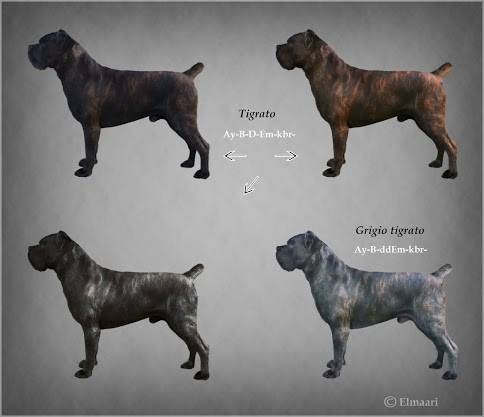
The brindle color is caused by kbr allele existence and is shown by strips of black or gray color on a red background. The form, width, frequency and arrangement of stripes depends on numerous genes modifiers.
All standard brindle dogs have a mask on their face, in the tone of their stripes – black or gray color.
We can conditionally divide brindle colors into two subgroups – brindle and gray brindle.
a) Brindle.
Genetic formula Ay-B-D-Em-kbr-.
Dogs with black stripes of various width on a red background – from thin black stripes to almost black dogs with separate red speckles (such color is sometimes called black brindle), a black mask on the face and well pigmented black lips, eyelids and a black nose.
b) Gray brindle.
Genetic formula Ay-B-ddEm-kbr-.
Presence of factor pair dd weakens black color to gray.
Thus, dogs of this color have gray stripes of various width on a red background of any intensity (from pale-yellow to chestnut), a gray mask on the face, a gray nose and gray lips and eyelids.
Breeding two brindle dogs with each other it is genetically impossible to produce black or gray offspring.
The intensity of brindle-strips is not important – if there is any brindle colouring then, the offspring will have no clear black or gray color. There are some registered cases when from two brindle colored parents, phenotypically black puppies were born and they even received pedigrees in which it was specified that they are dogs of a black color.
In certain cases fine brindle-stripes are only revealed as a puppy grows up so if they are not visible at the time of registering the puppy, then these dogs are registered as black by mistake.
It is necessary to pay particular attention to the fact that such dogs are not genetically black when the time comes to incorporate them into a breeding program.
As an example we will imagine we have produced puppies of a fawn color with black and gray masks from a brindle and a gray brindle dogs. Both parents have to be kbrk heterozygotes:
We breed: Ay-B-DdEm-kbrk (brindle) X Ay-B-ddEm-kbrk (gray brindle)
we receive: =
Ay-B-DdEm-kbr-(brindle);
Ay-B-ddEm-kbr-(gray brindle);
Ay-B-ddEm-kk (fawn with a gray mask);
Ay-B-DdEm-kk (fawn with a black mask).
Non-standard colors.
As we have already discussed, besides the colors determined by the standard, some undesirable colors do occur in the breed.
Dogs of undesirable colors undoubtedly are still Cane Corso, showing all the breed traits and born from two pedigree parents, but such dogs must be excluded from any breeding program.
It is necessary to pay attention to the parents of these dogs because all the undesirable colors in the breed are caused by recessive alleles, and the birth at least of one puppy of a non-standard color means that both of his parents are carriers of these unwanted recessive alleles.
Let’s consider undesirable colors that are most often met in breed.
1 . The tan color is characterised by the existence of red marks in certain places – on the legs, on the breast, on the face.
The attached image: Tan and tan brindle colors il disegno 008
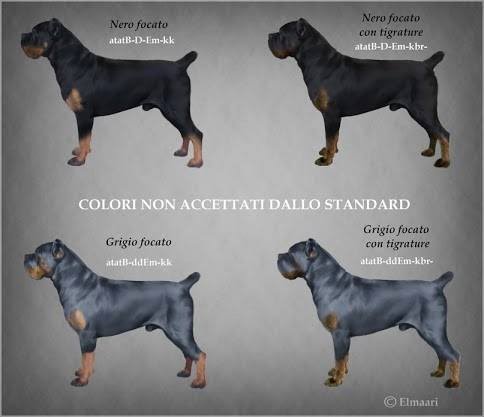
Spots have the correct form and make the character pattern of red color of any intensity. They can be present in any clear color.
Formation of a tan color is caused by existence in a genotype of factor pair atat.
- Black-and-tan. Genetic formula atatB-D-Em-kk.
Black dogs with red marks, black lips, eyes and a black nose.
- Gray-and-tan. Genetic formula atatB-ddEm-kk.
Dogs of gray color with red marks, gray lips, eyes and a gray nose.
At a combination of atat alleles and kbr- the tan brindle is formed fell.
In this case on the tan marks there are strips of black or gray color of various widths.
- Black and tan brindle Genetic formula atatB-D-Em-kbr-.
Black dogs with red marks on which there are strips of black color of various width. Dogs of this color have black lips, eyes and a black nose.
- Gray with tan brindle Genetic formula atatB-ddEm-kbr-.
Gray dogs with red marks on which there are strips of gray color of various width. Dogs of this color have a gray lips, eyes and a gray nose.
Quite often dogs with tan brindle are confused with brindle dogs whose stripes are mainly of black or gray color over the body as the red is less obvious . For more exact identification of a color it is necessary to pay attention to color of extremities of the dog – dogs with tan brindle extremities are often of a lighter than their main body color.
2 . The brown (liver) color is formed by the presence in genotype of a dog of factor pair bb, that causes synthesis of brown eumelanin.
Genetic formula Ay-bbD-Em-K-.
Dogs of a brown color with brown lips, eyes and a brown nose.
3 . The isabella color represents a pinkish and cream color with blue or chocolate tinges, and in this color the nose, eyelids and lips of a dog are a pinkish color.
Appearance of this color is caused by a combination of alleles dd and bb weakening a black pigment to gray and respectively causing synthesis of brown eumelanin.
Genetic formula of a color of Ay-bbddEm-K-.
4 . Fawn without a mask (recessive e-fawn).
Existence in a genotype of a dog of factor pair ee completely blocks the existence of eumelanin in its hair coat, that means these are dogs without any black hair at all on their body.
It phenotypically differs from standard fawn colors with the total absence of a mask. Cases when dogs of this color at dog shows were not disqualified, probably, are registered because their color was defined mistakenly as fawn with poorly expressed black or gray mask.
Three types of e-fawn:
- dogs of a fawn color without mask with black lips, eyes and a black nose. Genetic formula – B-D-ee-.
- dogs of a fawn color without mask with brown lips, eyes and a brown nose that is caused by existence in a genotype of couple of allely bb. Genetic formula -bbD-ee–.
- dogs of a fawn color without mask with gray lips, eyes and a gray nose, is caused by existence in a genotype of couple of alely dd. Genetic formula – B-ddee-.
So as we can see, the formation of undesirable colors in Cane Corso breed is caused by recessive genes. These dogs are all born from parents of standard colors who are invisible (recessive) carriers of undesirable allele.
We breed: Ay-BbDdEm-K-(black) X Ay-BbddEm-K-(gray)
we receive =
Ay-B-DdEm-K-(black),
Ay-B-ddEm-K-(gray),
Ay-bbDdEm-K-(brown),
Ay-bbddEm-K-(isabella).
When breeding dogs of non-standard colors with standard colors, frequently puppies will turn out standard colors, but the gene for the undesirable colour will still be carried by these puppies who one day may produce an undesirable color. Therefore animals of undesirable colors need to be excluded from all breeding.
We breed: AyAyB-D-Em-K-(black) X atatB-D-Em-kk (black-and-tan)
we receive =
AyatB-D-Em-Kk (black).
The attached image: Brown, isabella and fawn without a mask il disegno 009 colors
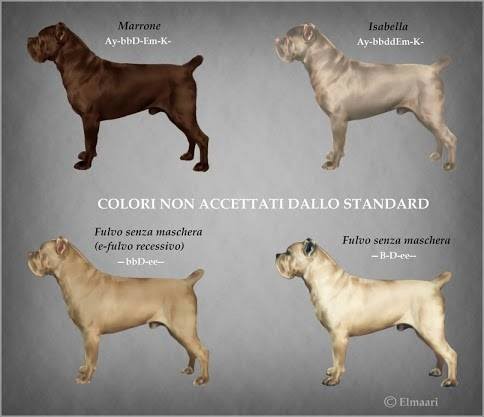
Dogs of non-standard colors sometimes participate in breeding. For example, tan dogs are not always identified visually.
Some dog owners and breeders consider that tan (and also other dogs of non-standard colors – isabella, fawn without a mask) with the correct anatomy can be used in breeding.
Fifteen years ago maybe this was necessary but today there is no need. Today we have enough dogs with an excellent exterior and the correct color.
The presence of the alleles leading to non-standard colors shouldn’t be considered normal for the breed, so for this reason we should try to remove them from our gene pool. The only way to dp this is to remove such dogs from breeding programs, including their parents who are carriers of these undesirable colors.
On a note to breeders. Some practical advice.
Finally there is some practical advice for breeders as it is possible to identify the genotype of specific producers and to consider this knowledge when planning a breeding program.
Firstly – it is necessary to pay attention to parents of a dog.
If, for example, one of parents of black, fawn with a black mask or a brindle dog is fawn with a gray mask, gray brindle or gray color, this dog is unambiguous heterozygotic on a locus (D) This means that any breeder, not paying attention to color when choosing parents, can increase the chance of getting in a litter from this dog puppies of weakened (diluted) colors (standard gray variants).
If the dog of black, gray, brindle, gray brindle color was born from the fawn dog with black or gray mask, it bears in a recessive deposit allele k and with careful selection of the parents it is possible to get puppies who are fawn with a black or gray mask from this dog.
The second – it is impossible to ignore past litters of any specific producer.
If from black, fawn with a black mask or brindle dog, puppies of gray, gray brindle or fawn color with a blue mask were born, our producer is a carrier of allele d.
And, respectively, if from black, gray, brindle or gray brindle dog just one fawn puppy with a black or gray mask was born, then the parent carries allele k.
In case of a fawn puppy with a gray mask we can claim with absolute certainty, that both of his parents, regardless of their color are carriers of at least of two alleles – d and k.
If a black or gray parent when bred with a fawn dog with a black or gray mask produce even one puppy of brindle or a gray brindle color then this black or gray parent is a carrier of Kkbr heterozygotes.
Special attention needs to be paid to producers from whom there was at least one puppy of undesirable colors, as non-standard colors in the breed are controlled by recessive alleles & their combinations.
Thus, here we have considered the main genetic aspects of color formation in the Cane Corso breed. Probably, future discoveries in the genetics of colors will necessitate amendments in this article, however at present all aspects considered in it are current for Cane Corso breeders.
The used literature:
1. Malkolm B. Willis “Geneticist of dogs”, Tsentrpoligraf, 2000
2. Sotskaya M.N. “Genetics of colors and hair cover of dogs”, AST, Akvarium-Print 2010
3. Pasechnik L.A. “Melanogenezys of dogs. Article is hooliganic, but it’s making everything clear”, http://alvheim.ucoz.ru/publ/4-1-0-29
4. Harchenko Tatyana “Inheritance of colors in Cane Corso breed”, http://www.cane-korso.com/genet.html
Source and full copyright © Genetic of color - Cane Corso All right reserved: http://www.nicolamille.com/
Náhledy fotografií ze složky Genetic code of colurs Cane corso (©Nicola Mille)



